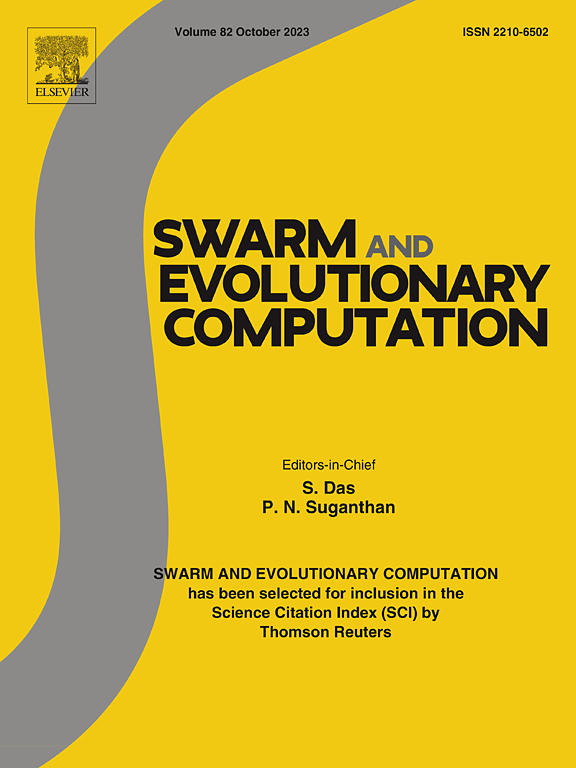维度窗口法:一种插件式的进化算法大规模处理技术
IF 8.5
1区 计算机科学
Q1 COMPUTER SCIENCE, ARTIFICIAL INTELLIGENCE
引用次数: 0
摘要
大规模优化构成了许多现实世界问题的关键特征,其中大规模进化算法作为解决此类复杂性的有力工具而出现。然而,现有的方法通常只针对特定类别的问题进行定制,并且缺乏通用性,无法适应其他进化算法或跨不同问题领域的一般化。为了解决上述问题,本文提出了维度窗口方法,这是一种简单而有效的增强方法,可以无缝地集成到低维进化算法中,以提高它们在大规模优化中的性能。具体来说,维度窗口方法涉及在每次迭代期间将随机选择的维度子集分组到一个窗口中,将种群的进化限制在该窗口内的维度。进一步分析了维数窗方法的有效性,并在此基础上改进了维数窗方法,包括等距分割的个体水平窗长度和神经网络引导的窗元。在单目标、多目标、约束多目标和大规模属性的离散测试问题上的大量实验表明,该方法显著减轻了维数诅咒,提高了进化算法在大规模环境下的性能。更显著的优势在于,所提出的插件不仅在解决比率误差估计问题等现实挑战时表现出卓越的性能,而且还可以轻松集成到现有的进化算法平台中,同时对进化算法用户具有高度的用户友好性。本文章由计算机程序翻译,如有差异,请以英文原文为准。
Dimensional window method: A plug-in-style large-scale handling technique for evolutionary algorithm
Large-scale optimization constitutes a pivotal characteristic of numerous real-world problems, where large-scale evolutionary algorithms emerge as a potent instrument for addressing such intricacies. However, existing methods are typically tailored to address only a particular class of problems and lack the versatility to be readily adapted to other evolutionary algorithms or generalized across diverse problem domains. To address the issue above, this paper proposes the dimensional window method, a simple yet effective enhancement that can be seamlessly integrated into low-dimensional evolutionary algorithms to bolster their performance in large-scale optimization. Specifically, the dimensional window method involves grouping a subset of randomly selected dimensions into a window during each iteration, restricting the population’s evolution to the dimensions within this window. Furthermore, the effectiveness of the dimensional window method is analyzed, and the window is improved based on the insights gained, including the isometric segmentation individual-level window length and the neural network-guided window element. Extensive experiments on single-objective, multi-objective, constrained multi-objective, and discrete test problems with large-scale attributes demonstrate that the proposed method significantly mitigates the curse of dimensionality and enhances the performance of evolutionary algorithms in large-scale settings. A more significant advantage lies in the fact that the proposed plug-ins not only demonstrate remarkable performance when tackling real-world challenges, such as ratio error estimation problems, but also offer easily integration into existing evolutionary algorithm platforms, all while being highly user-friendly for evolutionary algorithm users.
求助全文
通过发布文献求助,成功后即可免费获取论文全文。
去求助
来源期刊

Swarm and Evolutionary Computation
COMPUTER SCIENCE, ARTIFICIAL INTELLIGENCEC-COMPUTER SCIENCE, THEORY & METHODS
CiteScore
16.00
自引率
12.00%
发文量
169
期刊介绍:
Swarm and Evolutionary Computation is a pioneering peer-reviewed journal focused on the latest research and advancements in nature-inspired intelligent computation using swarm and evolutionary algorithms. It covers theoretical, experimental, and practical aspects of these paradigms and their hybrids, promoting interdisciplinary research. The journal prioritizes the publication of high-quality, original articles that push the boundaries of evolutionary computation and swarm intelligence. Additionally, it welcomes survey papers on current topics and novel applications. Topics of interest include but are not limited to: Genetic Algorithms, and Genetic Programming, Evolution Strategies, and Evolutionary Programming, Differential Evolution, Artificial Immune Systems, Particle Swarms, Ant Colony, Bacterial Foraging, Artificial Bees, Fireflies Algorithm, Harmony Search, Artificial Life, Digital Organisms, Estimation of Distribution Algorithms, Stochastic Diffusion Search, Quantum Computing, Nano Computing, Membrane Computing, Human-centric Computing, Hybridization of Algorithms, Memetic Computing, Autonomic Computing, Self-organizing systems, Combinatorial, Discrete, Binary, Constrained, Multi-objective, Multi-modal, Dynamic, and Large-scale Optimization.
 求助内容:
求助内容: 应助结果提醒方式:
应助结果提醒方式:


